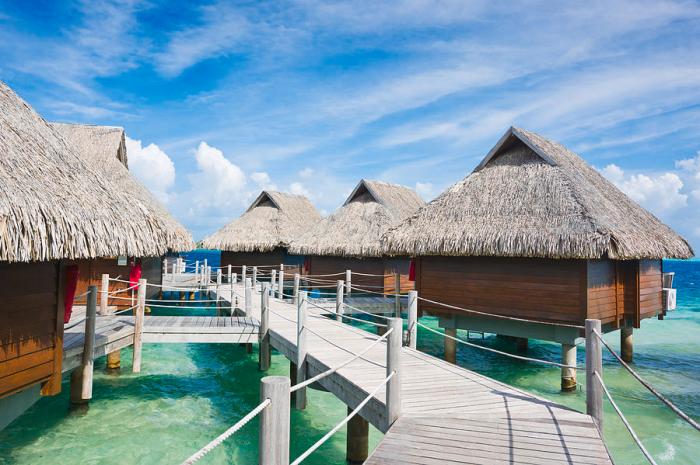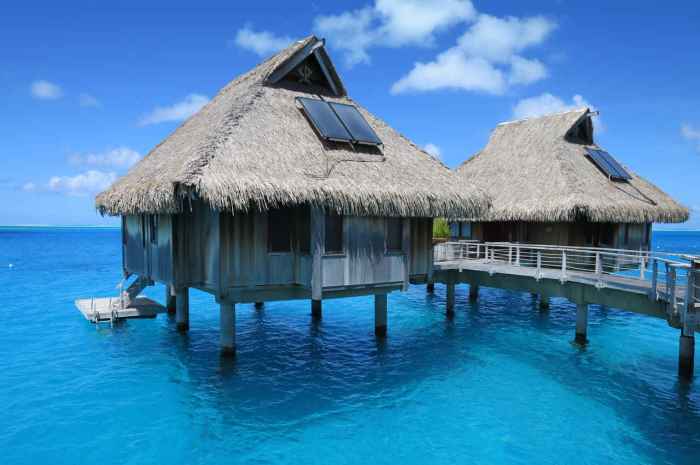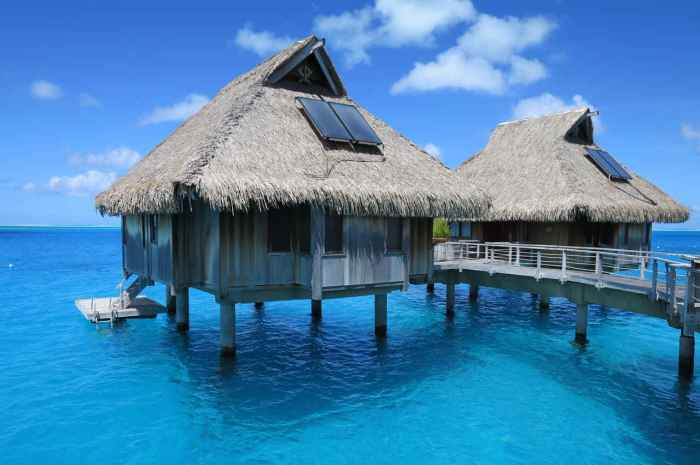Bora Bora huts, renowned for their distinctive thatched roofs and open-air designs, are architectural marvels that embody the cultural heritage of Polynesia. From their traditional origins to modern adaptations, these iconic structures offer a fascinating glimpse into the rich history and diverse architectural traditions of the Pacific Islands.
Throughout this exploration, we will delve into the intricate architectural features, cultural significance, and environmental impact of Bora Bora huts. We will also examine their role in tourism and hospitality, as well as their influence on contemporary architectural designs. Join us as we uncover the captivating world of Bora Bora huts, where tradition and innovation harmoniously coexist.
Bora Bora Huts
### Unique CharacteristicsBora Bora huts are traditional Polynesian dwellings found on the island of Bora Bora in French Polynesia. They are characterized by their unique design, which features a thatched roof made from pandanus leaves, supported by a framework of wooden poles.
The walls are typically made from woven mats or bamboo, and the floor is usually covered with sand or gravel.Bora Bora huts are not only functional but also have cultural significance. They represent the traditional way of life of the Polynesian people, and are often used for ceremonies and other cultural events.###
History and EvolutionThe history of Bora Bora huts can be traced back to the early Polynesian settlers of the island. These settlers brought with them the knowledge of how to build these huts, which were well-suited to the tropical climate of Bora Bora.Over
time, the design of Bora Bora huts has evolved to meet the changing needs of the people. For example, some huts now have modern amenities such as electricity and running water. However, the basic design of the hut has remained the same, and they continue to be an important part of the culture of Bora Bora.
Architectural Features: Bora Bora Huts

Bora Bora huts, also known as “fares” in the local Polynesian language, are renowned for their distinctive architectural features that blend traditional Polynesian design with modern comforts. These huts are typically characterized by their thatched roofs, open-air design, and elevated platforms, reflecting a deep connection to the surrounding environment and sustainable building practices.
Bora bora huts, with their iconic thatched roofs and overwater decks, offer a serene and luxurious retreat. While they’re typically associated with tropical destinations like the Maldives and Tahiti, these huts can also be found in more unexpected locations like Ibiza.
During the ibiza winter , when the island’s party scene quiets down, bora bora huts provide a peaceful haven for travelers seeking relaxation and rejuvenation. From secluded coves to lively beach clubs, these unique accommodations offer a blend of comfort and exotic charm.
Thatched Roofs
The most striking feature of Bora Bora huts is their thatched roofs, meticulously crafted using natural materials such as dried coconut palm leaves, pandanus leaves, or woven reeds. These roofs provide excellent insulation, protecting the interior from the tropical heat and humidity.
The thatching technique involves layering the leaves or reeds in overlapping rows, creating a thick and durable covering that can withstand strong winds and heavy rainfall.
Open-Air Design
Bora Bora huts embrace an open-air design, allowing for natural ventilation and a seamless connection to the outdoors. The huts typically feature large windows and sliding doors that can be opened wide, creating a spacious and airy living environment. This design not only provides ample natural light but also allows occupants to enjoy the breathtaking views of the lagoon and surrounding nature.
Elevated Platforms
Many Bora Bora huts are built on elevated platforms, raised above the ground level. This design serves several purposes. Firstly, it protects the huts from flooding during high tides or storms. Secondly, it provides a cooler and more comfortable living space by elevating it above the humid ground level.
Thirdly, the elevated platforms offer panoramic views of the surroundings, allowing occupants to fully appreciate the beauty of their natural setting.
Natural Materials and Sustainable Building Practices
Bora Bora huts are constructed using natural and sustainable materials, reflecting the local Polynesian culture’s deep respect for the environment. The use of locally sourced materials, such as wood, bamboo, and thatching, minimizes the environmental impact of construction. Additionally, traditional building techniques, passed down through generations, ensure that the huts are built in harmony with the surrounding ecosystem.
Cultural Context
Bora Bora huts, known as faresin the Polynesian language, hold significant cultural and spiritual importance within Polynesian society. These structures serve as gathering places for traditional ceremonies, rituals, and social events, embodying the cultural heritage and traditions of the Polynesian people.
Ceremonial and Ritual Use
Bora Bora huts are central to various traditional ceremonies and rituals, including:
- Weddings: Faresserve as venues for traditional Polynesian weddings, where the couple exchanges vows and is blessed by the community.
- Births:They provide a sacred space for childbirth, where expectant mothers are cared for and supported by the community.
- Funerals: Faresare used as a place of mourning and remembrance, where the deceased are honored and their spirits are believed to reside.
Social Gatherings
Beyond their ceremonial significance, Bora Bora huts are also essential for social gatherings and community events:
- Village meetings: Faresserve as meeting places for village elders and community members to discuss important matters and make decisions.
- Feasting and celebrations:They are used for communal feasts, celebrations, and special occasions where the community comes together to share food, music, and dance.
- Storytelling and cultural exchange: Faresprovide a space for storytelling, cultural performances, and the传承ing of traditional knowledge and customs.
Preservation of Cultural Heritage
Bora Bora huts play a vital role in preserving and传承ing Polynesian cultural heritage:
- Architectural legacy:The unique design and construction techniques of faresembody the architectural skills and knowledge of Polynesian ancestors.
- Cultural practices:The use of faresfor traditional ceremonies, rituals, and social gatherings helps to maintain and传承 cultural practices and beliefs.
- Sense of identity: Faresare a tangible symbol of Polynesian identity and provide a sense of continuity and connection to the past.
Tourism and Hospitality
Bora Bora huts play a crucial role in the tourism industry, contributing to the island’s allure as a top-rated destination. These iconic structures serve as both accommodations and attractions, offering a unique and immersive cultural experience.
Resorts and accommodations featuring Bora Bora huts provide guests with an authentic Polynesian ambiance. The huts are typically built over the water, offering breathtaking views of the lagoon and surrounding scenery. They are equipped with modern amenities such as air conditioning, private bathrooms, and comfortable furnishings, ensuring a luxurious and comfortable stay.
Unique Experiences and Amenities
- Overwater dining experiences with panoramic views of the lagoon.
- Traditional Polynesian cultural performances and activities.
- Private decks or balconies for relaxation and sunbathing.
- Glass-bottom floors for underwater viewing of marine life.
- Romantic sunset cruises and stargazing opportunities.
Impact on Preservation and Sustainability
The growing popularity of tourism has had a significant impact on the preservation and sustainability of Bora Bora huts. To meet the demands of tourists, new resorts and accommodations have been constructed, leading to increased development on the island. This has raised concerns about the potential impact on the environment and the preservation of the island’s cultural heritage.
Efforts are being made to balance tourism development with the preservation of Bora Bora huts. Sustainable practices are being implemented, such as using eco-friendly materials, minimizing waste, and protecting marine life. Additionally, cultural preservation initiatives are underway to ensure that the traditions and heritage associated with Bora Bora huts are passed down to future generations.
Modern Adaptations
Bora Bora huts have evolved to meet the demands of modern living while preserving their traditional charm. These adaptations include the use of new materials and technologies, as well as the integration of Bora Bora hut elements into contemporary architectural designs.
One notable adaptation is the use of sustainable materials in the construction of Bora Bora huts. Thatched roofs, once made from natural materials like palm leaves or pandanus, are now often replaced with synthetic materials like polyethylene or nylon. These materials are more durable and resistant to the elements, reducing the need for frequent repairs and replacements.
Contemporary Bora Bora Hut Designs
Modern Bora Bora hut designs incorporate elements of traditional architecture with contemporary aesthetics. These designs often feature open floor plans, large windows, and elevated platforms to maximize natural light and ventilation. The use of glass and steel complements the natural materials, creating a harmonious blend of tradition and modernity.
The integration of Bora Bora hut elements into modern architectural designs extends beyond private residences. Public spaces such as resorts, restaurants, and even office buildings have incorporated Bora Bora hut-inspired elements, such as thatched roofs, open-air structures, and the use of natural materials.
Sustainability and Environmental Impact

Bora Bora huts have a complex relationship with the environment. Their construction and tourism activities can have both positive and negative impacts on the surrounding ecosystem. Understanding these impacts is crucial for promoting sustainable practices and preserving the natural beauty of Bora Bora.
Environmental Impact of Bora Bora Hut Construction
The construction of Bora Bora huts can have several environmental consequences. The use of traditional materials such as wood and thatch can lead to deforestation and the depletion of natural resources. Additionally, the construction process can disturb local wildlife and disrupt delicate ecosystems.
- Deforestation: The construction of Bora Bora huts requires large amounts of wood, which can lead to deforestation if not sourced sustainably.
- Resource depletion: The use of natural materials such as thatch can deplete local resources, especially if not harvested responsibly.
- Wildlife disturbance: Construction activities can disrupt local wildlife, particularly during nesting and breeding seasons.
Environmental Impact of Tourism Activities, Bora bora huts
Tourism activities associated with Bora Bora huts can also have environmental impacts. The influx of tourists can lead to pollution, waste generation, and increased pressure on local resources.
- Pollution: Tourists can contribute to pollution through activities such as boating, snorkeling, and fishing, which can release pollutants into the water and air.
- Waste generation: Tourism activities generate significant amounts of waste, which can pose a threat to the environment if not properly managed.
- Resource depletion: The increased demand for resources such as water and energy can put a strain on local resources, especially during peak tourist seasons.
Comparative Analysis
Bora Bora huts, along with Hawaiian hale and Tahitian fares, are traditional Polynesian structures that showcase the architectural ingenuity and cultural heritage of the Pacific Islands. While sharing commonalities in their design and purpose, each type of dwelling possesses unique features and characteristics that reflect the distinct cultural traditions and environmental adaptations of the respective regions.
Similarities
These Polynesian structures share several similarities:
- Raised Platforms:All three types of huts are built on raised platforms, providing protection from moisture, insects, and potential flooding.
- Thatched Roofs:The roofs are typically thatched with natural materials such as palm leaves or pandanus, offering shelter from the sun and rain.
- Open Floor Plans:The interiors feature open floor plans, allowing for flexibility in use and maximizing airflow.
- Communal Spaces:These huts often serve as communal spaces for gatherings, storytelling, and other social activities.
Differences
Despite their similarities, Bora Bora huts, Hawaiian hale, and Tahitian fares exhibit notable differences:
- Shape and Size:Bora Bora huts are typically larger and more conical in shape than Hawaiian hale and Tahitian fares, which tend to be smaller and more rectangular.
- Roof Structure:Bora Bora huts have a unique double-roof structure, with an outer layer of thatch and an inner layer of woven coconut leaves, providing superior insulation and weather protection.
- Ventilation:Hawaiian hale often feature large openings or windows to promote cross-ventilation, while Tahitian fares have smaller openings and rely more on natural airflow through the thatched roof.
- Cultural Significance:Bora Bora huts hold significant cultural importance as symbols of traditional Polynesian architecture and are often used for ceremonial purposes.
Design Inspiration and Architectural Applications
Bora Bora huts have captured the attention of architects and designers, inspiring a range of contemporary architectural designs. Their unique form and construction techniques have been adapted and integrated into various structures, fostering a dialogue between traditional and modern architectural practices.
The use of natural materials, such as wood, thatch, and bamboo, has found its way into residential designs, creating a sense of warmth and connection to the environment. The open and airy nature of Bora Bora huts has influenced the design of public spaces, promoting natural ventilation and interaction with the surroundings.
Commercial Applications
- Restaurants and Resorts:Bora Bora huts have become popular architectural elements in beachside resorts and restaurants, evoking a sense of tropical paradise and relaxation.
- Retail Spaces:The use of thatch roofs and bamboo walls in retail stores creates a unique and inviting ambiance, enhancing the customer experience.
Sustainability and Cultural Sensitivity
- Sustainable Practices:The use of local and sustainable materials in Bora Bora huts aligns with principles of green architecture, minimizing environmental impact.
- Cultural Sensitivity:Incorporating elements of Bora Bora huts into architectural designs can foster cultural appreciation and understanding, preserving traditional building techniques.
Artistic Representations and Cultural Expressions
Bora Bora huts have been a prominent source of inspiration for artists, writers, and storytellers throughout history. Their unique architectural form and cultural significance have been captured in various art forms, including paintings, sculptures, literature, and music.
In Polynesian art, Bora Bora huts are often depicted as symbols of home, community, and tradition. They are frequently featured in paintings and sculptures, where they are adorned with intricate carvings and vibrant colors. These artistic representations reflect the importance of these structures in Polynesian culture, where they serve as gathering places, sleeping quarters, and symbols of family lineage.
Paintings and Sculptures
Bora Bora huts have been the subject of numerous paintings and sculptures, capturing their beauty and cultural significance. Notable examples include:
- Paul Gauguin’s “The Hut” (1892): This painting depicts a Bora Bora hut nestled amidst lush vegetation, highlighting the harmony between nature and human habitation.
- “Bora Bora Hut” by Gauguin (1892): This sculpture captures the intricate carvings and architectural details of a Bora Bora hut, showcasing the craftsmanship and artistry involved in its construction.
Literature and Storytelling
Bora Bora huts have also played a significant role in Polynesian literature and storytelling. They are often featured in tales and legends, where they serve as settings for important events and symbolize the cultural identity of the Polynesian people.
- “The Legend of the Bora Bora Hut” tells the story of a young man who builds a hut for his beloved, using his tears as the mortar to hold the structure together.
- “The Hut on the Lagoon” by James Michener (1953): This novel features a Bora Bora hut as a central setting, exploring the lives of the people who live in and around it.
Last Point
Bora Bora huts stand as testaments to the ingenuity and cultural heritage of Polynesian societies. Their unique architectural features, sustainable construction practices, and deep-rooted cultural significance make them invaluable assets to the preservation and传承 of Polynesian traditions. As we continue to appreciate and learn from these remarkable structures, may we strive to balance tourism development with environmental sustainability, ensuring that future generations can continue to marvel at the beauty and cultural richness of Bora Bora huts.
Essential FAQs
What is the significance of Bora Bora huts in Polynesian culture?
Bora Bora huts serve as communal gathering spaces, ceremonial venues, and symbols of cultural identity within Polynesian societies.
How are Bora Bora huts constructed?
Traditionally, Bora Bora huts are built using natural materials such as wood, bamboo, and palm leaves, with a focus on sustainability and harmony with the environment.
What is the role of Bora Bora huts in tourism?
Bora Bora huts are central to the tourism industry in Bora Bora and other Polynesian destinations, offering unique and immersive experiences for visitors.



